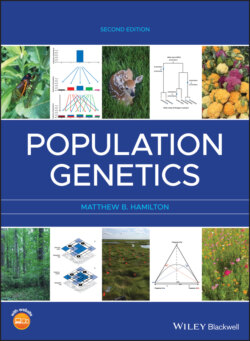Читать книгу Population Genetics - Matthew B. Hamilton - Страница 18
Interact box 1.1 The textbook website
ОглавлениеThroughout this book, you will encounter Interact boxes. These boxes contain opportunities for you to interact directly with the material in the text by using computer simulations designed to demonstrate fundamental concepts of population genetics. Each box will contain step‐by‐step instructions for you to follow in order to carry out a simulation. By following the instructions, you will get started with the simulation. However, always feel free to use your own imagination and intuition. After following the instructions in the Interact box and understanding the point at hand, enter different values, push more buttons, and even read the documentation. You can also return to Interact boxes at a later time, perhaps after you have read and understood more of the text, to reconsider a simulation or view it in a different light. You can also use the simulations to answer questions that may occur to you or to test hypotheses that you may have. Questions in population genetics that start off “What would happen if…?” can often be answered with simulation.
The book's website gives you the worldwide web address (URL) for each interact box. This prevents problems in case web addresses change because the website can be updated while your copy of the text cannot be updated.
Step 1 Open a web browser and enter http://www.wiley.com/go/hamiltongenetics
Step 2 Click on the Chapter resources link that is associated with Interact boxes.
Step 3 Verify that the page gives links for each of the Interact boxes listed by their number. You could also bookmark this page so you can access it directly in the future.
Congratulations! You have completed the first Interact box.
Simulations are an effective means to understand some of the fundamental predictions of populations genetics. Mathematical expressions are frequently used to express dynamics and equilibria in population genetics, but the equations alone can be opaque at first. Simulations provide a means to explore the relationships among variables that are summarized in the compact language of mathematics. Many people feel that a set of mathematical equations is much more meaningful after having the chance to explore what they describe with some actual numerical values. Simulation provides the means to explore what equations predict and can make learning population genetics an easier, more rewarding experience.
Carrying out simulations has the potential to make the expectations of population genetics much more accessible and understandable. Conducting simulations is not much extra work, especially once you get into the practice of using the text and simulation software in concert. You can approach simulations as if they are games, where each one shows a visual scene that helps to solve a puzzle. In addition, simulations can help you develop a more intuitive understanding of population genetic predictions so you do not have to approach the expectations of population genetics as disembodied or unanimated “facts.”
It is important to approach simulations in a systematic and organized fashion, not as just a collection of buttons to press and text entry boxes to be filled in on a whim. It is absolutely imperative that you understand the meaning behind each variable that you can control as well as the meaning of the results you obtain. To do so successfully, you will need to be aware of both specific details and larger patterns, or both the individual trees and the forest that they compose. For example, in a simulation that presents results as a graph, it is important that you understand the details of what variables are represented on each axis and the range of axis values. Sometimes these details are not always completely obvious in simulation software, requiring you to use both your intuition and knowledge of the population genetic processes being simulated.
Once you are comfortable with the details of a simulation, you will also want to keep track of the “big picture” patterns that emerge as you view simulation results. Seeing these patterns will often require that you examine the results over a range of conditions. Try approaching simulations as experiments by changing only one variable at a time until you understand its effects on the outcome. Changing several things all at once can lead to confusion and an inability to see cause‐and‐effect relationships, unless you have fully understood the effects of individual variables. Finally, try writing down parameter values you have tried in a simulation and sketching or tabulating results on paper as you work with a simulation. Use all of your skills as a scientist and student when conducting simulations, and they will become a powerful learning tool. Eventually, you may even use scripting and programming to carry out your own simulations specifically designed to explore your own genetic hypotheses.
